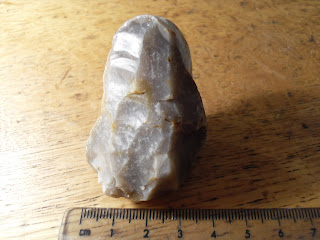
It was good to be able to do some digging the other day, and following on from my "Victoria to the Bronze Age" blog, I found some teeth !
No, not somebody’s long lost dentures, but real “tussy pegs”.

Obviously they were animal teeth, which I suspect were from some old sheep that’s probably been buried here when it was a field, many moons ago. But I have to admit it did get me going for a while, and kept a wary eye out for any other signs that I was perhaps digging up someone's resting place.
It reminded me of this little poem which I find quite moving, and yet funny at the same time.
Ah, are you digging on my grave ? by (Thomas Hardy)
"Ah, are you digging on my grave,
My loved one? -- planting rue?"
--"No: yesterday he went to wed
One of the brightest wealth has bred.
'It cannot hurt her now,' he said,
'That I should not be true.'"
"Then who is digging on my grave,
My nearest dearest kin?"
-- "Ah, no: they sit and think, 'What use!
What good will planting flowers produce?
No tendance of her mound can loose
Her spirit from Death's gin.'"
"But someone digs upon my grave?
My enemy? -- prodding sly?"
-- "Nay: when she heard you had passed the Gate
That shuts on all flesh soon or late,
She thought you no more worth her hate,
And cares not where you lie.
"Then, who is digging on my grave?
Say -- since I have not guessed!"
-- "O it is I, my mistress dear,
Your little dog , who still lives near,
And much I hope my movements here
Have not disturbed your rest?"
"Ah yes! You dig upon my grave...
Why flashed it not to me
That one true heart was left behind!
What feeling do we ever find
To equal among human kind
A dog's fidelity!"
"Mistress, I dug upon your grave
To bury a bone, in case
I should be hungry near this spot
When passing on my daily trot.
I am sorry, but I quite forgot
It was your resting place."















